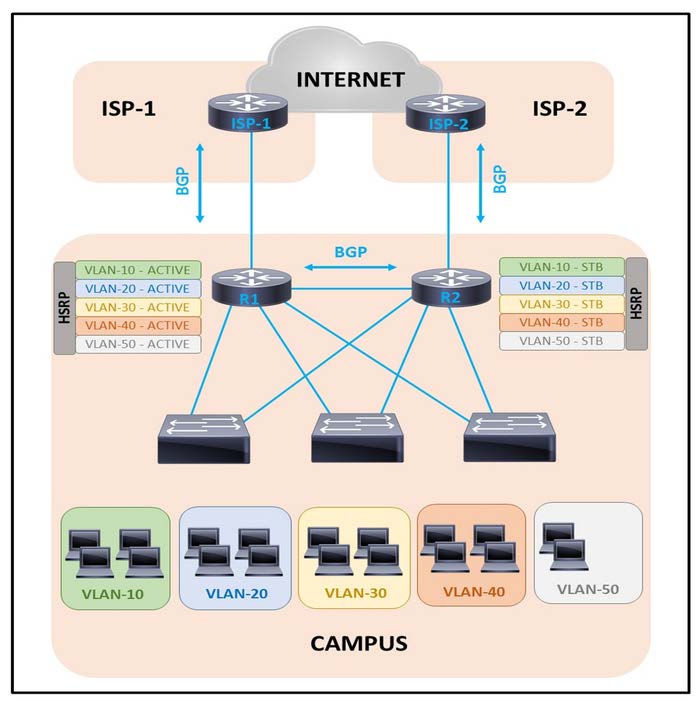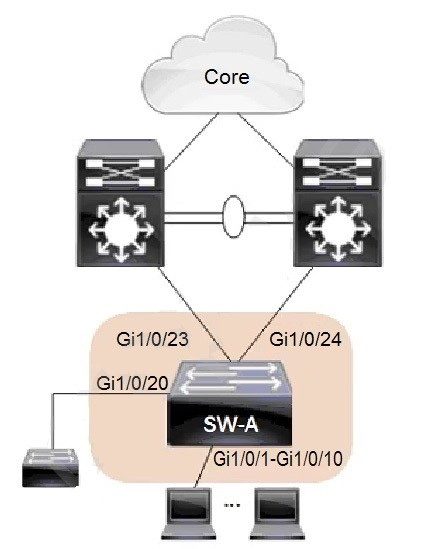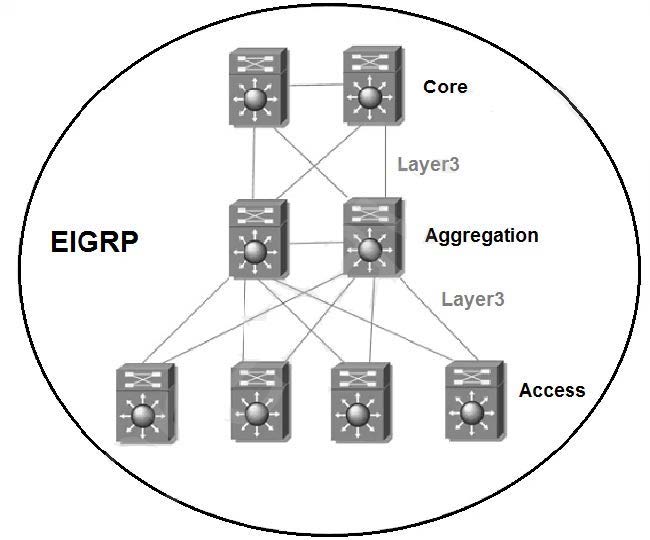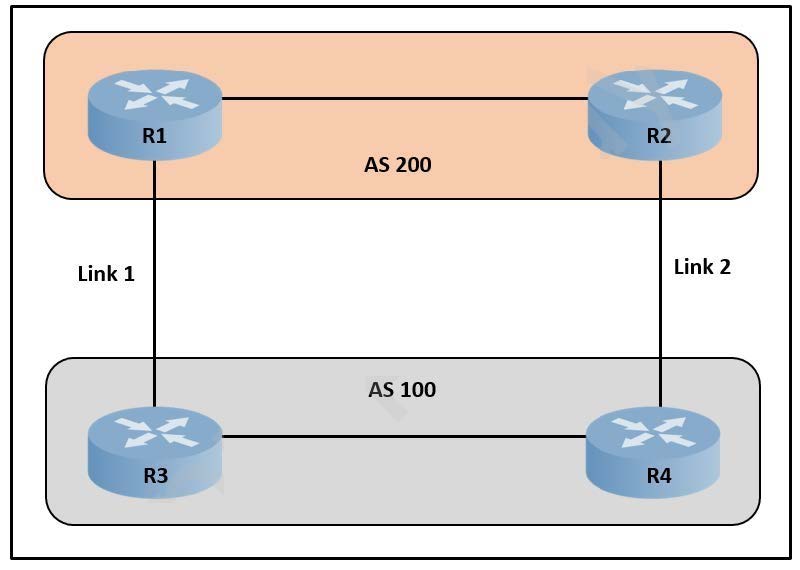Exam Details
Exam Code
:300-420Exam Name
:Designing Cisco Enterprise Networks (ENSLD)Certification
:CCNP EnterpriseVendor
:CiscoTotal Questions
:388 Q&AsLast Updated
:Mar 31, 2025
Cisco CCNP Enterprise 300-420 Questions & Answers
-
Question 91:
An architect must develop a campus network solution that includes:
1.
logically segmented and isolated networks
2.
ability to communicate between network segments when required
3.
support for overlapping IP addresses
4.
widely available technologies to avoid purchasing specialized equipment
Which solution must the architect select?
A. VSS with IGP
B. 802.1Q with HSRP
C. vPC with HSRP
D. VRF-Lite with OSPF
-
Question 92:
Refer to the exhibit.

A customer is running HSRP on the core routers. Over time the company has grown and requires more network capacity. In the current environment, some of the downstream interfaces are almost fully utilized, but others are not. Which solution improves the situation?
A. Make router R2 active for half of the VLANs.
B. Add more interfaces to R1 and R2.
C. Configure port channel toward downstream switches.
D. Enable RSTP on the downstream switches.
-
Question 93:
Which topology within a network underlay eliminates the need for first hop redundancy protocols while improving fault tolerance, increasing resiliency, and simplifying the network?
A. virtualized topology
B. routed access topology
C. Layer 2 topology
D. logical fabric topology
-
Question 94:
An engineer must design a large Layer 2 domain that contains hundreds of switches and VLANs. The engineer's primary goals are to:
1.
Efficiently utilize the bandwidth of all links
2.
Avoid Layer 2 loops
3.
Cause minimal impact on switch CPU and memory Which technology should the engineer include in the design?
A. MST
B. Rapid PVST+
C. RSTP
D. PVST+
-
Question 95:
Refer to the exhibit. An architect reviews the low-level design of a company's enterprise network and advises optimizing the STP convergence time. Which functionality must be applied to Gi1/0/1-10 to follow the architect's recommendation?

A. UplinkFast
B. root guard
C. BPDU guard
D. PortFast
-
Question 96:
Refer to the exhibit. Where must an architect plan for route summarization for the topology?

A. from the core toward the aggregation and the access toward the aggregation
B. from the core toward the aggregation and the aggregation toward the core
C. from the aggregation toward the access and the access toward the aggregation
D. from the aggregation toward the core and the aggregation toward the access
-
Question 97:
Refer to the exhibit.

The full EIGRP routing table is advertised throughout the network. Currently, users experience data loss when any one link in the network fails. An architect must optimize the network to reduce the impact when a link fails. Which solution should the architect include in the design?
A. Run BFD on the inter links between EIGRP neighbors.
B. Summarize the access layer networks from each access layer switch toward the aggregation layer.
C. Reduce the default EIGRP hello interval and hold time.
D. Summarize the access layer networks from the aggregation layer toward the core layer.
-
Question 98:
Refer to the exhibit.

An engineer must design a WAN solution so that ISP-1 is always preferred over ISP-2. The path via ISP-2 is considered as a backup and must be used only when the path to ISP-1 is down. Which solution must the engineer choose?
A. R1:
-
Routes advertised to ISP-1: 0x AS-path prepend
-
Routes received from ISP-1: HIGH local-preference
-
Routes advertised to R2: no action
-
Routes received from R2: community NO-EXPORT
R2:
-
Routes advertised to ISP-2:5x AS-path prepend
-
Routes received from ISP-2: LOW local-preference
-
Routes advertised to R1: community NO-ADVERTISE
-
Routes received from R1: no action
B. R1:
-
Routes advertised to ISP-1: 0x AS-path prepend
-
Routes received from ISP-1: HIGH local-preference
-
Routes advertised to R2: community NO-EXPORT
-
Routes received from R2: no action
R2:
-
Routes advertised to ISP-2: 5x AS-path prepend
-
Routes received from ISP-2: LOW local-preference
-
Routes advertised to R1: no action
-
Routes received from R1: no action
C. R1:
-
Routes advertised to ISP-1: 0x AS-path prepend
-
Routes received from ISP-1: LOW local-preference
-
Routes advertised to R2: community NO-ADVERTISE
-
Routes received from R2: no action
R2:
-
Routes advertised to ISP-2: 5x AS-path prepend
-
Routes received from ISP-2: HIGH local-preference
-
Routes advertised to R1: no action
-
Routes received from R1: community NO-ADVERTISE
D. R1:
-
Routes advertised to ISP-1: 5x AS-path prepend
-
Routes received from ISP-1: LOW local-preference
-
Routes advertised to R2: community NO-ADVERTISE
-
Routes received from R2: no action
R2:
-
Routes advertised to ISP-2: 0x AS-path prepend
-
Routes received from ISP-2: HIGH local-preference
-
Routes advertised to R1: community NO-EXPORT
-
Routes received from R1: no action
-
Question 99:
Which component is part of the Cisco SD-Access overlay architecture?
A. border node
B. spine node
C. leaf node
D. Cisco DNA Center
-
Question 100:
Refer to the exhibit.

A network engineer is designing a network for AS100. The design should ensure that all traffic enters AS100 via link 1 unless there is a network failure. In the event of a failure, link 2 should function as the path for incoming traffic. Which solution should the design include?
A. Modify the next-hop attribute on R3.
B. Use AS-Path prepending on R3.
C. Modify the next-hop attribute on R4.
D. Use AS-Path prepending on R4.
Related Exams:
300-410
Implementing Cisco Enterprise Advanced Routing and Services (ENARSI)300-415
Implementing Cisco SD-WAN Solutions (ENSDWI)300-420
Designing Cisco Enterprise Networks (ENSLD)300-425
Designing Cisco Enterprise Wireless Networks (ENWLSD)300-430
Implementing Cisco Enterprise Wireless Networks (ENWLSI)300-435
Automating and Programming Cisco Enterprise Solutions (ENAUTO)300-440
Designing and Implementing Cloud Connectivity (ENCC)350-401
Implementing and Operating Cisco Enterprise Network Core Technologies (ENCOR)
Tips on How to Prepare for the Exams
Nowadays, the certification exams become more and more important and required by more and more enterprises when applying for a job. But how to prepare for the exam effectively? How to prepare for the exam in a short time with less efforts? How to get a ideal result and how to find the most reliable resources? Here on Vcedump.com, you will find all the answers. Vcedump.com provide not only Cisco exam questions, answers and explanations but also complete assistance on your exam preparation and certification application. If you are confused on your 300-420 exam preparations and Cisco certification application, do not hesitate to visit our Vcedump.com to find your solutions here.